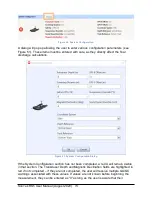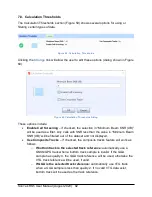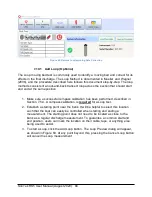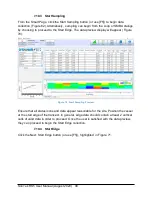
SonTek RS5 User Manual (August 2020) 76
entered in the Temperature Override variable, which will be used over the measured
temperature.
7.5.5.6 Sound Speed Override
As with the Temperature Override feature, the sound speed measured by an external
measurement can be entered here to override the automatic calculation using the
measured temperature by the RS5.
7.5.5.7 Magnetic Declination
When using GNSS/GPS as a track reference, it is essential to enter a correct magnetic
declination to ensure that the velocity vectors and components have the correct heading. On the
earth's surface, a calibrated compass indicates magnetic north rather than geographic north.
The angular difference between these two directions defines the magnetic declination (also
known as variation, magnetic variation, or compass variation). Magnetic declination varies
across the earth's surface and over time. The magnetic declination angle (θ) can be found on
maps or referenced online from nearby stations such as airports. Avoid using old maps, as
magnetic declination can change substantially over time. A good source now is using Apps
(e.g. Compass in Google Play or Declination in App Store).
7.5.5.8 Coordinate System
The Coordinate System defines the axes by which the velocity vectors and profiles are plotted
and reported. This drop down menu has three options. All options are available for post
processing; however you can set the default for the measurement.
Beam
: Beam coordinates are relative to the orientation of the transducers on the head of
the ADP. Beam coordinates are typically used for diagnostics purposes only.
XYZ
:
Transforms beam velocities into a typical right-hand XYZ Cartesian coordinate
system. The positive X axis is in the direction of beam 1, marked by an arrow next to the
transducer. The positive Z axis is up. This choice is also rarely used.
ENU
: Applies the ENU (East, North, Up) coordinate system to the data. Local ENU
coordinates are formed from a plane tangent to the Earth's surface fixed to a specific
location. This is the most common choice for standard measurements.
7.5.5.9 Depth Reference
Two options exist for determining water depth. Both options are available for post-processing
and the user can choose the default reference.
Vertical Beam
: Applies data from the vertical transducer to determine water depth for
the cross-sectional area. This choice is often preferred as it applies to the depth directly
below the instrument.
Bottom-Track
: This option averages depth values measured by the four angled beams
to determine water depth.
















































